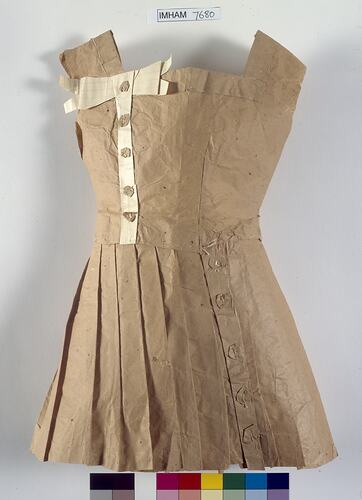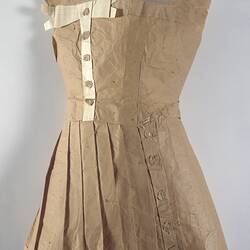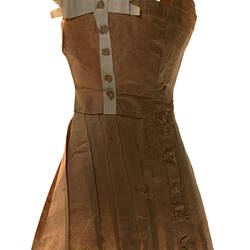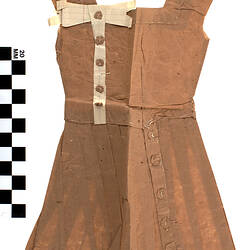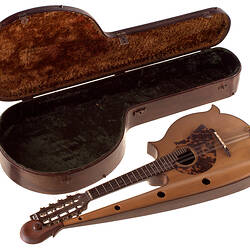Summary
One of six paper patterns, made in Italy around 1954 by Anna Fantini when she was 11 years old. It is a copy of women's clothing made by Anna for her imaginary dolls, as her family could never afford to buy her a real doll. Anna applied all her dressmaking skills to this pattern and used cigarette paper to make buttons and belts.
Anna Fantini, nee Improta was born in Torre Annunziata, a town near Naples, Italy, in 1943. Her family was very poor and they were forced to take her out of school when she was around 10 years old. Soon after Anna completed an apprenticeship in dressmaking with a local dressmaker for two years. Anna migrated to Australia with her husband and children in 1981. They were granted entry on humanitarian grounds as they were victims of the 1981 earthquake that devastated the Campania region. Anna had two sisters in Melbourne, one of whom had arrived in 1954.
Physical Description
The pattern is of brown paper, with trimming of cream paper on the right-hand side; it is sleeveless with a square neckline, and trimmed with brown paper buttons . The skirt is pleated and the pattern has been assembled and sewn with white cotton.
Significance
This paper doll's dress is part of a small but evocative collection which represents poverty, resilience and childhood skills. It also represents the importance of material culture in maintaining connections to childhood memories, memories that can be both reassuring and painful. This is particularly significant within the context of migration narratives where people are not only disconnected from possessions but from homeland as well.
More Information
-
Collection Names
Museums Victoria/Italian Historical Society Co.As.It Collection
-
Collecting Areas
Working Life & Trades, Migration & Cultural Diversity, Childhood
-
Acquisition Information
Donation from Mrs Anna Fantini, 17 Jun 1996
-
Maker
-
Classification
-
Category
-
Discipline
-
Type of item
-
Overall Dimensions
33 cm (Length), 43 cm (Height)
Due to shaping measurements are taken at maximum.
-
Exhibition Collection Management
430 mm (Length), 310 mm (Width), 110 mm (Height)
height indicates height of item when laying flat but mounted on support
-
Dimensions
440 mm (Length), 320 mm (Width)
Measurement From Conservation. Measuring Method: measured folded out
-
Keywords
Dolls, Dressmaking, Handcrafts, Italian Communities, Italian Immigration, Making Do, Working Life
